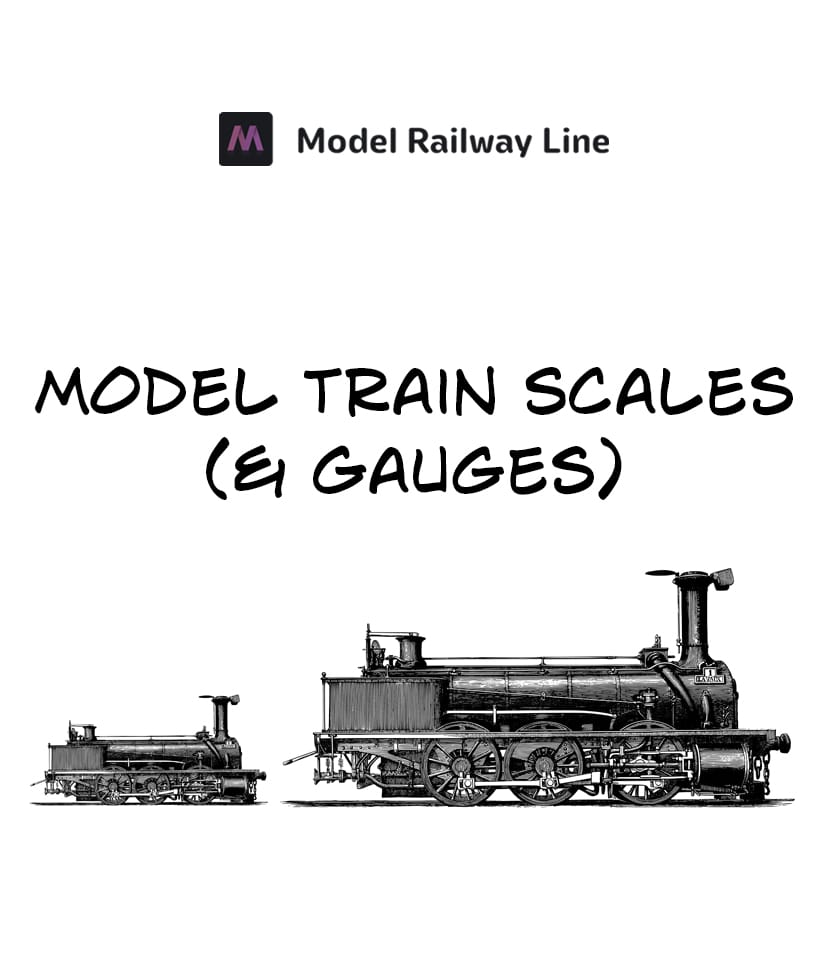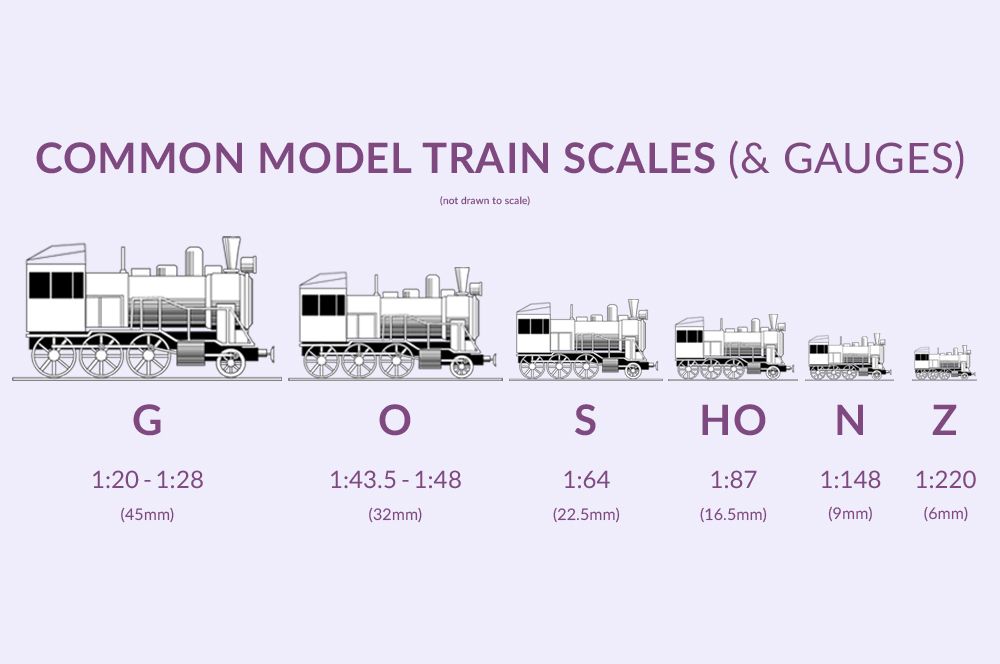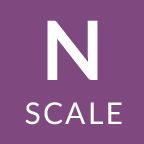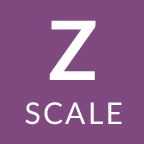What are Model Train Scales? Modelling Gauges Explained
Model trains come in a variety of scales and gauges. This guide explains model train scales in detail and considers the best gauge to use in rail transport modelling. A number of commercially available model railway gauges can be used to build a great layout.

Model trains come in a wide variety of scales and gauges. In this guide we'll explain what model train scales are, cover some essential concepts for modellers, consider the difference between scale and gauge in model trains, and determine which train scale is best for rail transport modelling.
Train Models
The history of train models dates all the way back to the 1860s when the first documented toy trains were made from metal and wood. In 1891 the first mass market model trains were produced by Märklin in Germany. A number of other model train manufacturers followed suit in the subsequent years. These early train models weren't built to any standard or specific scale and there was no way for different brands of model train to work together. This was unsatisfactory from a modeller's standpoint as a model train from one manufacturer wouldn't work with the track from another.
As the model railroad industry matured over time a set of industry standards were agreed upon and the manufacturers chose to produce their train models to common scales. This allowed intercompatibility between different brands of model train and track in the same gauge, which was of great benefit to modellers.
Fast forward to the present day and there are numerous brands who produce train models in these gauges - there's a plethora of options available for modellers to purchase.
So, what are model train scales? In this guide we explain the scales of model train in detail, from larger G scale through to tiny Z scale.

Model Train Scales Explained
Model trains are available in a range of different sizes, known as "scales". The scale of a model is its relative size in proportion to the real-world equivalent. For example, an HO scale model train is 1/87th the size of the real thing. So, for an HO scale model of the Flying Scotsman, you'd need 87 of them in order to match the length of the original full size version.
The distance between the two rails is called the modelling gauge. Full size 'real' trains run on a standard gauge, which has a distance of 4' 8.5'' between the inside edges of both rails. In the world of model trains, HO gauge models run on track gauge that's only 0.625''/16.5mm wide, so at a much smaller scale than the real world original.
The difference in size between the model and the real world equivalent is known as the scale ratio. For example, 1:48 indicates that the model is 48 times smaller than the original full size version.
Model train scales come in a number of commercially available sizes which range from tiny to very large. We'll detail a number of these below.
G Scale Model Trains

LGB (Lehmann Gross Bahn) were responsible for introducing G scale trains to the model railroad industry. These model trains were first produced by Ernst Paul Lehmann Patentwerk in the 1960s and then by Märklin from 2007 onwards.
G scale model trains are most commonly used in outdoor garden railways due to their size and robustness. Many of these trains are also weatherproof, making them ideally suited to outdoor use. They can also be used in large indoor areas, if desired.
While G gauge trains offer robust, reliable operation and fantastic detail, they are very large models - even the smallest G scale layouts will require a lot of real-world space.
Advantages
- Highly detailed models
- Robust & reliable operation
Disadvantages
- Take up a lot of space
G scale vs G gauge
G gauge trains have a model gauge of 1.75''/45mm (the distance between both the rails on the tracks). However, this does not define the scale in which the models are built. This needs to vary to ensure the track width is consistent whilst taking into account the variety of real-world railroad gauges that can be modelled.
Simply put, G gauge refers to all model trains that can run on 1.75''/45mm width track whereas G scale is a specific scale size (1:22.5).
This is where G model railways differ from other types as different scales are able to be run on G gauge track.
For example, F scale (typically used to model narrow gauge trains from North America) has a ratio of 1:20.32 and G scale (used to model 1 metre gauge European trains) has a ratio of 1:22.5 and both of these scales will run on G gauge track.
This allows a number of different railway gauges to be modelled in this size. Here's a summary of the model train scales that can run on G gauge track:
| Name | Ratio | Notes |
|---|---|---|
| Gauge one | 1:32 | Models standard gauge (4ft 8.5in) trains. |
| A scale | 1:29 | Used to model standard gauge prototypes. Not in common use. |
| G scale | 1:22.5 | Models European metre gauge trains. |
| H scale (1/2 inch) | 1:24 | Models 3ft 6in gauge trains. |
| F scale (fifteen) | 1:20.32 | Typically models North American narrow gauge 3ft trains. |
| Seven eighths | 1:13.7 | Models narrow gauge 2ft trains. |
| 16mm scale | 1:19.05 | Originally used to model 2ft gauge on 32mm track. Can also model 2ft 6in trains. |
O Gauge Trains

O gauge trains were first introduced by German manufacturer Märklin in the early 1900s. By the 1930s O gauge became the most popular model railroad scale in the USA where it remained until the 1960s.
Over the years O gauge trains decreased in popularity as the hobby evolved from being solely focused on toy trains into producing models with far higher levels of detail, with a shift in focus on greater levels of accuracy and realism leading to smaller scales being introduced and becoming more popular.
It remains a popular scale with model railway hobbyists who prefer running trains to the other aspects of railway modelling. Collectors often favour O gauge trains due to the popularity of reproduction models and the market for vintage locomotives.
The specifications for O gauge and O scale trains can be confusing as there are inconsistent standards in place for different countries and regions. Typically, the model gauge ranges from 1.181''/30mm to 1.3''/33mm.
O gauge specifications
The scale ratio of the models also varies by country. Here's a summary of the various O scale ratio standards for different regions:
| Country | Scale Ratio |
|---|---|
| United States | 1:48 |
| Germany, Japan, Russia | 1.45 |
| United Kingdom, France | 1:43.5 |
Advantages
- Large detailed models
- Popular reproduction models and vintage locomotives
Disadvantages
- Standards differ by region
- Less popular than other gauges
S Scale Trains

S scale trains are one of the oldest railway modelling scales. According to many in the industry, their popularity peaked during the 1950s. However, in subsequent years the demand for these trains slowly declined due to the introduction of other model railway gauges. In recent years there's been somewhat of a resurgence in the popularity of S scale trains with the reintroduction of Lionel's American Flyer range.
S scale model trains have a scale ratio of 1:64 and a model gauge of 0.885''/22.48mm.
HO Model Trains

Up until the 1960s O gauge was the most popular model train scale. However, these trains proved quite large - taking up a lot of space in the average home - and were becoming more expensive to produce. Manufacturers wanted to provide a more suitable alternative for smaller home layouts and needed the production process to be more cost effective. HO model trains were first created with these requirements in mind.
During the 1960s HO scale started to overtake O scale in terms of popularity. Around this time a number of leading brands, such Marx and Lionel (who were best known for manufacturing other gauges), began to produce HO trains. This meant modellers began to have a wide variety of products to choose from and effectively lowered the barrier of entry to the model train hobby for many people.
HO model trains are now considered to be the most popular model train scale in the world. Although OO gauge is more popular in the UK.
HO model trains have a scale ratio of 1:87 and a model gauge of 0.65''/16.5mm.
This sizing makes them a fantastic 'middle ground' model railroad scale - they strike a good balance between the level of detail and accuracy being modelled and the fact that they don't require huge amounts of space.
If you're looking to build your first model train layout we would recommend choosing HO scale as it's the easiest modelling gauge to get started with. (Except if you're from the UK when we would recommend OO gauge - see below for more detail on this).
Advantages
- The most popular train scale in most of the world
- Widely available - lots of choice
- Mature second hand market
Disadvantages
- More experienced modellers may be looking to explore other scales
OO Gauge Trains

Although HO model trains are the most popular model train scale in the majority of the world, this is not the case in the UK where OO gauge trains are the market leading model train gauge.
OO gauge model railways were orignally launched in 1921 by German company Bing, and were known as the "Table Railway". The following year the first British locomotive prototypes started to appear and were all powered by clockwork mechanisms. In 1923 the first electrically powered OO gauge trains arrived.
In 1938 Meccano launched their range of Hornby Dublo OO gauge models and this resulted in the popularity of OO gauge trains soaring. It has remained the most popular model train scale in the UK ever since.
OO gauge trains never became established in other countries such as the USA. Despite attempts by brands such as Lionel trying to introduce OO gauge trains to the US market, they never took off and HO gauge remained the more popular scale.
OO trains use the same gauge track as HO - 0.65''/16.5mm. However, they have a scale of 4mm to 1ft and a ratio of 1:76.2, making them slightly larger than HO trains. OO gauge trains can run on HO gauge track.
This size makes them a great beginners model train scale. It's a managable size for most home layouts and there's a vast array of choice with a large number of OO gauge train sets available from many different manufacturers.
If you're from the UK and are looking to build your first model railway layout we would certainly recommend choosing OO gauge. It's got the lowest barrier to entry of the model train scales and is the easiest to get started with. There's also so much choice with regard to the train sets available to purchase.
Advantages
- Most popular train scale in the UK
- Easy to get started
- Lots of beginners train sets available
- Can run on HO track
Disadvantages
- Generally only popular in the UK
- More experienced modellers may be looking to explore other scales
N Gauge Train Sets

N gauge is a smaller model train scale that's established itself as one of the most popular commercially available scales.
It's often the model train gauge that hobbyists go to when moving on from their first model railway. It's a good gauge to experiment with the different aspects of railroad modelling at a smaller scale.
While N gauge train sets are relatively small, they are by no means the smallest model train gauge. Z gauge are smaller still.
N gauge train sets use a model gauge of 0.354''/9mm.
The scale ratio of N gauge train sets varies slightly by country. However, they are approximately half the size of HO scale models. The following is a list of the various N scale ratio standards for different regions:
| Country | Scale Ratio |
|---|---|
| United Kingdom | 1:148 |
| Japan | 1:15 |
| Other | 1:16 |
Advantages
- Great option for smaller spaces
- Good alternative to HO or OO gauge
- Allows modellers to refine their skills in a smaller scale
Disadvantages
- Not as popular as HO or OO gauges
HO vs N Scale
One of the main advantages of N scale is that it allows modellers to build layouts that take up significantly less space than HO scale. The smaller size of the models allow more interest to be included in the available space.
However, N scale model trains often prove to be less cost effective than their HO scale counterparts due to the reduced choice and often more limited availability of products. That's not to say that there are so few N gauge train sets available that it would prevent you from building a great model train layout - more so that HO gauge has a greater level of popularity, so more products are available in comparison.
So, is HO or N scale better? If you live in a small house or are generally limited by the space in which you can build your model railway, N gauge is a good choice. However, for most people HO gauge would be the recommended scale - particularly for beginners where it's deemed the standard gauge for starter train sets.
Both HO and N scale are great options. The choice you make will likely be determined by the space in which you are building your model railroad and your level of experience as a model railway hobbyist.
Z Scale Model Trains

A relatively modern train scale in comparison to other gauges, Z scale model trains were first introduced by Märklin in 1972. In its infancy Z gauge was primarily thought of as a European train scale. However, over time it has aquired more of a following in other regions such as North America and Asia. As Z scale has matured it has developed a large community of enthusiasts who regularly participate in model railroad exhibitions and shows in order to show off the benefits of this model train scale and what can be achieved in small scale modelling.
Z scale is one of the smallest model train scales currently on the market. It has a scale ratio of 1:220 and a model gauge of 0.256''/6.5mm.
It's ideally suited to small spaces or where a compact layout is required. They are also great for portable model train layouts due to the smaller size and lighter weight. However, it is significantly more challenging to ensure reliable operation with Z gauge than it is with other larger model train scales, such as HO or N gauge. The small size of Z scale, and the low weight of the rolling stock, mean it is more susceptible to dirt or corrosion on the track than other gauges. For reliable operation track must be kept extremely clean. Refer to our guide on how to clean model railway track for the recommended methods to use.
There's also a significantly smaller market for Z scale model trains, and less choice of products - including rolling stock and accessories.
Advantages
- Good for small spaces and compact layout designs
- Easier to transport due to the small size
Disadvantages
- Reliable operation is more challenging compared to larger scales
- Limited number of products available
We also have a seperate detailed guide to Z scale model trains - be sure to check this out for more information on this model train scale.
Model Train Scale Reference Chart
If you're looking for a quick guide to the different model train scales we've got you covered! Below you'll find our reference chart for the most popular model train scales.
| Notation | Ratio | Scale | Track gauge |
|---|---|---|---|
| G | 1:20 - 1:29 | Various | 45mm |
| O (NMRA standard, US) | 1:48 | 0.25'' | 1.25'' |
| O (MOROP standard, Europe) | 1:45 | 6.8mm | 32mm |
| O (UK standard) | 1:43.5 | 7mm | 32mm |
| S | 1:64 | 3/16'' | 22.5mm |
| HO | 1:87.1 | 3.5mm | 16.5mm |
| OO | 1:76.2 | 4mm | 16.5mm |
| N | 1:148 | 2.06mm | 9mm |
| Z | 1:220 | 1.4mm | 6mm |
Summary of Model Train Scales
In this guide we've looked in detail at what model train scales are. Let's review the key points from the areas we've covered.
- Gauge refers to the distance between the two rails on model railway tracks.
- Scale refers to the size of the model in comparison to the real version. For example, 3.5mm to 1ft scale means every foot in reality is equivalent to 3.5mm on the model.
- Ratio is the difference in size between the model and the real world equivalent. For example, 1:48 means that the model is 48 times smaller than the original.
If you're just getting started as a model railway hobbyist then we would always recommend choosing the model train scale that's best suited to your budget and the amount of space that you have available.
For your first model railway layout we would recommend building in HO gauge (or OO gauge if you're in the UK) as this is the easiest model train scale to get started in.
After you've completed a few model train projects you can move on to experimenting with different rail modelling gauges and scales. Many railroad modellers enjoy the unique challenges that each of the different scales bring and end up having numerous layouts in alternate gauges.
Be sure to check out the other guides in our train set series for more beginners tips and advice on how to get started with model train scales.

